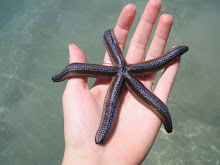Glaciers begin to move when the pressure from above actually breaks apart the chemical bonds of the ice in a process called deformation. Glaciologists are actually physists in disguise, so I don't pretend to know the tricky details, but deformation (read melting) combined with the gravity on a mountain slope causes the glacier layers to flow downward very very slowly. Cracks and crevasses then occur when some layers travel faster than others. The process known as "calving" refers to when pieces of tidewater glaciers (those that come up to the water - what we've got here) fall off into the sea. This doesn't necessarily happen because the glacier is melting, but because it is being pushed from behind.
 Of course, you need not know all of those things to appreciate a glacier. As I have learned, all you need to do is go climb on one! Alice and I made our second trip up our backyard glacier today and had a grand time. My first odd realization was how hard and crunchy it really was. My second thought was that I couldn't wait for the view. When we reached the midpoint rescue cache and snowmobile, I realized that the hike would be much longer than we expected from our comfy vantage point at the bottom. Of course, it was beautiful from the top and WINDY all the way. We could see the valley and mountains behind the station that make me forget that we are actually on a big island. It was fantastic to look out on the other small islands and feel the vastness of it all.
Of course, you need not know all of those things to appreciate a glacier. As I have learned, all you need to do is go climb on one! Alice and I made our second trip up our backyard glacier today and had a grand time. My first odd realization was how hard and crunchy it really was. My second thought was that I couldn't wait for the view. When we reached the midpoint rescue cache and snowmobile, I realized that the hike would be much longer than we expected from our comfy vantage point at the bottom. Of course, it was beautiful from the top and WINDY all the way. We could see the valley and mountains behind the station that make me forget that we are actually on a big island. It was fantastic to look out on the other small islands and feel the vastness of it all. Today the quiet on the glacier was punctuated by the sudden and surprising sound of the glacier calving across the harbor. You see it before you hear it. If you're lucky enough to be looking at it when it starts, you get the full effect of the big moment. If not, you hear the building thunder of one hundred feet of ice rearranging itself and falling into the water, followed by the wave that ripples outward. Hours later, you can still see the brash ice floating outward from the glacier, which provides seal sleeping spots!
Seeing a few of these bigger calvs has reminded me about the importance of perspective. It is absolutely boggling that such a seemingly small piece of the glacier could create such a racket, but then you have to remember that the whole thing is gigantic, so the piece was not actually very small. Does that make sense? When our neighbor glacier was not grumbling, it was exceptionally quiet and I could hear the distinct tinkling of flowing water that had melted far below our feet. This might seem a little disconcerting, and in fact, it was. I have found that you have to bury dramatic visions of Hollywood crevasses and just trust your safety officers and the solid that you feel beneath your feet! Another great afternoon adventure.







That penguin fellow is mighty cute!
ReplyDeleteSO...FREAKIN...CUTE!!!
ReplyDelete